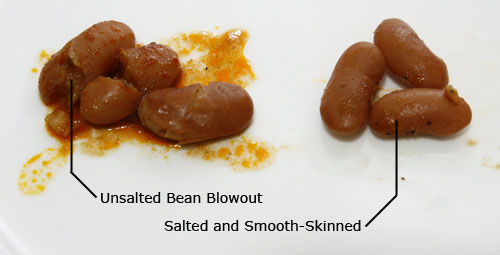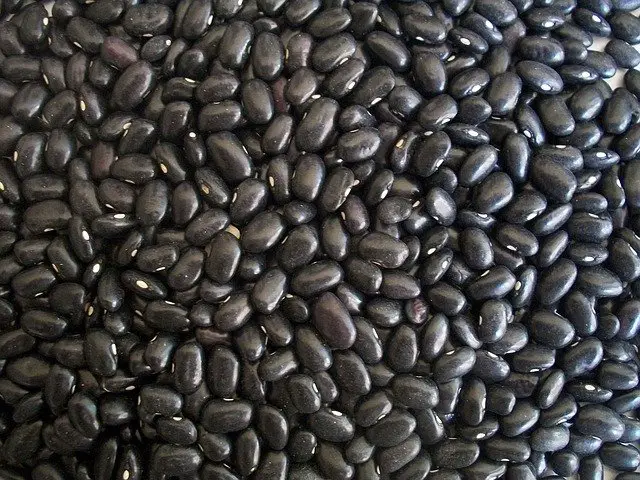
When I first started cooking with dried beans, they would always split, leaving them looking ugly and unappetising. I felt sure I was doing something wrong – how come everyone else ended up with beautiful, round, plump beans, whereas mine looked like a big mess? I decided to investigate! Here’s what I discovered.
Beans split when cooking because the interior of the bean rehydrates more quickly than the slightly tough exterior, causing it to expand, and pop out of the skin. This can be avoided by soaking the beans, to soften the skins, and by thoroughly salting the beans’ cooking water.
With just a couple of small adjustments to my cooking method, I am now able to cook dried beans perfectly every time, without any ugly, split skins! I can’t believe the difference these few small changes make.
First, we need to understand what’s actually happening as the beans cook, and why the beans split in the first place.
Why do beans split when cooking?

Obviously, dried beans need to rehydrate in order to be edible. Nobody likes crunching down on hard beans – and more than that, undercooked beans can actually cause food poisoning.
Annoyingly, the different parts of a dried bean often rehydrate at a different rate. The skin of a bean is slightly tough, and rehydrates quite slowly, whereas the softer interior of a bean rehydrates relatively quickly.
As the bean sucks in all that cooking water, gradually rehydrating, it expands, increasing in size by up to 200%!
Since the inside of the bean is expanding more quickly, it’s forced to break through the skin, causing it to split, and leading to that ugly mess you can see in the photo above.
If you think about it, it actually makes perfect sense for a bean to split open like this. After all, beans are essentially seeds, and if you planted them in the ground, they would split open to grow new plants. When you immerse the bean in water, you’re beginning the germination process, and the bean will start to break out of its skin in order to grow a new sprout. We just want to eat them before this happens!
Is it safe to eat split beans?
It is absolutely safe to eat beans that have split during cooking. As I said, this is a totally natural process, and it has no bearing on the safety or quality of the bean. They may look a bit untidy, but as long as the beans have been properly cooked, there is nothing wrong with eating those beans that split.
However, there’s no denying that split beans aren’t the most attractive looking things. For some meals, this won’t matter – nobody’s going to notice split beans if you’ll eventually be blending them into soup, for example. But if your beans will be particularly visible in the finished dish, and you take pride in the appearance of your cooking, you might want to try to avoid having split beans.
So, how can we avoid this happening?

How to avoid beans splitting during cooking
There are a few main things you can do to avoid your dried beans from splitting as you cook them:
1. Soak your beans thoroughly
Soaking your dried beans thoroughly before cooking will begin to soften the skins, meaning they will rehydrate more quickly when you then begin to cook them in boiling water.
Minimising the difference in cooking time of the interior and exterior of the beans will help to reduce the amount of splitting you get. The skin will be able to soften and expand along with the interior of the bean as they rehydrate, rather than the middle of the bean needing to break its way out of the skin.
So to end up with the most beautiful, plumpest beans possible, make sure you soak your beans for a good amount of time before cooking. If you have time to soak them overnight, that’s ideal. Of course, you can totally cook beans after less cooking time too, but you might be more likely to end up with split beans.
2. Salt your soaking and cooking water
Another thing you can try is to salt the water you use to boil your beans, as well as your soaking water.
And I don’t just mean you should add a tiny pinch of salt to a huge vat of beans – that will barely make any difference at all.
No, you need to heavily salt the water. It will help to prevent the beans from splitting, and has the added bonus of ensuring your beans are extra tasty, and seasoned perfectly evenly.
The reason this works is that as the beans soak in the salted water, some of the sodium ions in the salty water infiltrate the beans’ skins. They take the place of the calcium and magnesium ions in the skins, which are the substances that help to keep the beans firm. So by displacing those ions and disrupting the integrity of the beans’ skins, you’re making them easier to soften and stretch, and less likely to split during cooking.
…I know, it’s a bit sciency for some people, so don’t worry if you don’t know your ions from your irons. All you need to know is that salting your soaking and cooking water is a good thing for avoiding split beans!
Does salting the cooking water make beans cook more slowly?
There’s an old wives tale that adding salt to beans actually makes them take longer to cook – I’m sure there are grandmothers all over the world who would raise an eyebrow if you told them you soak your cooking water.
But luckily, this has been shown to not be true – salting your cooking water will not prevent your beans from cooking properly. In fact, salting your water may even make your beans cook more quickly! So go ahead and salt away – at the very least, you’ll end up with extra tasty beans.
It’s actually acid that can cause beans to cook slowly, so wait to add ingredients like lemon juice, vinegar or tomatoes after the beans have cooked fully, otherwise they may take a long time to become completely tender.
3. Use ‘fresh’ dried beans
I’m aware that this sounds like a bit of an oxymoron – what on earth is a ‘fresh’ dried bean? But just like anything else, dried beans have a shelf life. Okay, the shelf life is a lot longer for dried beans than for most other foods (they can generally last for at least a couple of years, if stored properly), but the quality of dried beans does still deteriorate slowly over time.
I’ve found that older dried beans are more likely to split than dried beans I’ve bought more recently. The beans become even drier as they get older, meaning they’ll soak up even more water, which only exacerbates the splitting problem.
So if you’re looking to avoid your beans splitting, make sure you’re cooking them fairly soon after you’ve bought them (perhaps, within a few months), rather than using that packet of beans you found in the back of your cupboard that’s been there since 2006 (no judgement, we’ve all got one!).
4. Don’t boil your beans too vigorously
Aside from all the chemistry-related stuff, there’s also one other thing you can try, to avoid split beans: don’t boil your beans too vigorously! The more you bash your beans around, the more likely you are to create small cracks and splits in the skins.
So treat your dried beans with kindness (it can be tempting to throw the bag straight into the cupboard, I know, but show them some love and be a bit more gentle!), boil them slowly, and don’t stir them too vigorously.
If you combine all four of these tricks, you’re sure to end up with beautiful, plump beans, with no split skins in sight!
